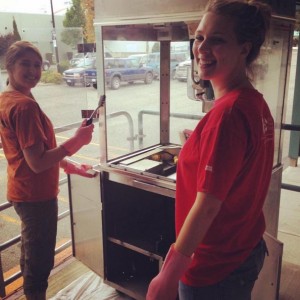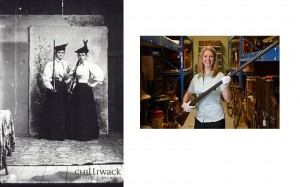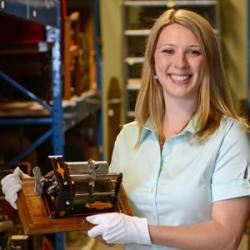
One of last summer’s curatorial projects was to carefully remove the sugar and mould from the former Paramount Theatre’s popcorn machines (Summer Student Mikaela Ramdial and Curator Jane Lemke)
One of the hardest questions I receive is: “What is a Curator?”. My answer is often rather awkward and rushed because frankly, it’s a big question and concise answer would reduce the true nature of my tasks; however, my best definition so far is: I am responsible for preserving and interpreting Chilliwack’s tangible history. The long, rather jumbled definition is, I am:
• Part conservator
• Part researcher
• Part historian
• Part scientist
• Part reference clerk
• Part graphic designer
• Part carpenter
• Part electrician and so much more.
Each day is different and that is one of the reasons why I love my job.
A substantial amount of my daily tasks revolve around exhibits. Beginning an exhibit is often the hardest part as the wealth of information available is astounding and it is my job to construct a narrative out of all the information. The archival collection has over 500,000 records including maps, photos, oral histories and paper records and the artifact collection has over 10,000 objects that range in size from a postage stamp to building rafters to extremely heavy canoes. Each item accepted into our collection has a strong connection to Chilliwack and we are privileged to preserve these records and artifacts for the public so that the history of Chilliwack is accessible for a long time.

This Booen glass-plate negative depicts three First Nations women posing in “pioneer” clothing. Chilliwack Museum and Archives, P003520
Our upcoming exhibit focuses on photography and will open on September 22nd, 2016. I am currently still in the research stage, trying to piece together various details, such as the price of cameras in 1905, the types of photographic papers that were used in the 1930s and the people behind the photographs in our collection. It’s a long process that results in a (fingers crossed) beautiful exhibit that highlights the contributions, memories and innovations made by Chilliwack’s photographic community throughout our City’s history.
One itinerant photographer was James Orville Booen, who set up a photographic studio in 1895-1897 here in Chilliwack. While he wasn’t in Chilliwack long, what is remarkable about Booen’s images is the consistency of the photographer’s vision. The images consist of studio portraits, scenes, streetscapes and outdoor portraits, which provides a substantial glimpse into Chilliwack before the turn of the last century and is one of the first complete photographic collections we have of Chilliwackians including First Nations as well as Japanese, Chinese and other immigrant groups that are often missing from the historic record during this time.

J.O. Booen’s portrait of Sarah Jane Muirhead and Flossie Hamilton holding rifles, exemplifies the “Wild West”. I did try to recreate Booen’s photo for our 2015 staff photos but for some reason, it didn’t look quite right.
One of my favorite photographs from the Booen Collection shows Sarah Jane Muirhead and Flossie Hamilton posing with rifles in the typical Victorian dress of the time. These women demonstrate the classic definition of a “pioneer woman”: strong, moral, and refined. The photographer’s scene construction is the cause, down to the feathers in their hats. Booen choose to display these women in this way and to evoke a sense of the “Wild West”.
Looking back through Chilliwack’s photographic history is truly an amazing treasure hunt. Stay tuned for more about our photography exhibit!


Comments are closed.